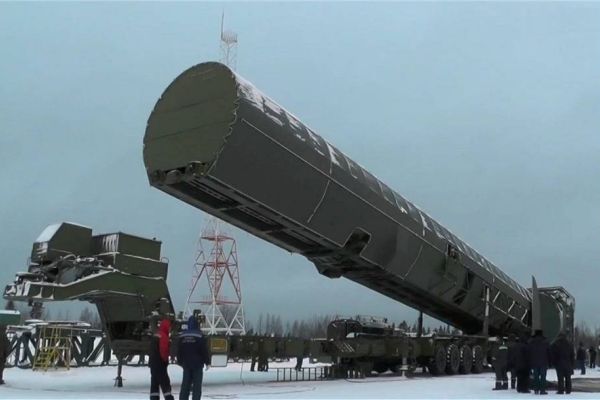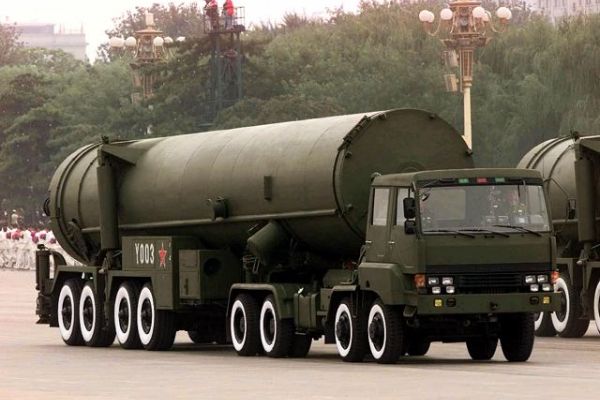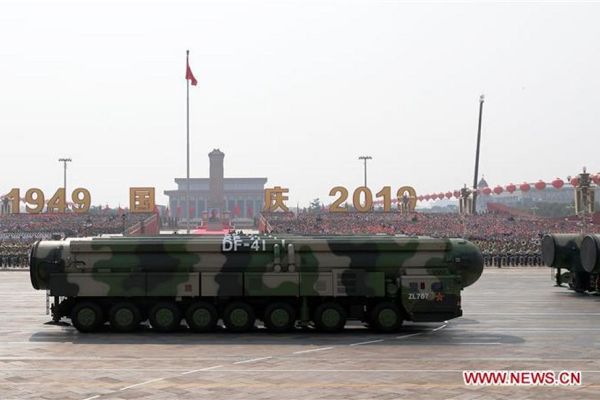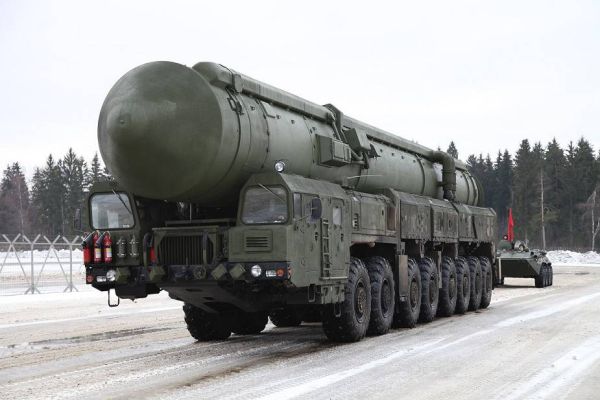ICBM Intercontinental ballistic missiles.
Minuteman III LGM-30 ICBM.

The Minuteman LGM-30 ICBM is a family of land-based, solid-fueled intercontinental ballistic missiles that were developed by Douglas Aircraft Company (later McDonnell Douglas, now part of Boeing). The missile was designed as a key component of the United States' nuclear deterrent strategy during the Cold War, providing the U.S. with a reliable and fast-response capability to strike global targets in the event of a nuclear conflict. The Minuteman series has evolved through several versions, with the Minuteman III being the current variant in service, and it remains one of the longest-serving and most dependable missile systems in history.
Country users: United States
Description
The Minuteman LGM-30 ICBM is a solid-fuel, InterContinental Ballistic Missile developed for the United States by Douglas Aircraft Company, which later became part of McDonnell Douglas and then Boeing. First deployed in 1962, the Minuteman ICBM system replaced older liquid-fueled missiles and was designed to provide a more rapid and survivable response to a nuclear threat. The missile was the first to use solid rocket motors, enabling a much faster launch capability and improving overall readiness compared to earlier systems that used liquid fuel.
Initially, the Minuteman I was designed to carry a single warhead, but improvements in guidance and warhead technology led to the development of subsequent versions like the Minuteman II and Minuteman III. The Minuteman II, deployed in 1966, featured improved targeting accuracy and the ability to carry a larger payload. The Minuteman III, introduced in 1970, incorporated Multiple Independently Targetable Reentry Vehicles (MIRVs), significantly enhancing the missile's deterrence capability by allowing it to strike multiple targets with a single missile.
These upgrades were part of an ongoing effort to ensure the system remained effective in the face of advancements in Soviet missile defense technologies. Today, the Minuteman III remains operational, although plans for its replacement with the Ground-Based Strategic Deterrent (GBSD) are underway, with the new system expected to be deployed in the 2030s. The role of the Minuteman missile, particularly the Minuteman III, remains crucial in maintaining the United States' strategic nuclear deterrence, providing the ability to retaliate against any nuclear attack on U.S. soil.
Minuteman LGM-30 variants:
- Minuteman I (LGM-30A/B): Entered Service: 1962
The first operational version, Minuteman I, was a revolutionary design that introduced solid-fuel propulsion to ICBMs, significantly reducing launch preparation time. It had two subvariants: the LGM-30A, which was the initial deployment model, and the improved LGM-30B, which featured better guidance accuracy. It was armed with a single nuclear warhead and had an operational range of approximately 9,650 kilometers. Though groundbreaking for its time, Minuteman I was relatively limited in accuracy and payload compared to later versions. It was fully retired by the mid-1970s.
- Minuteman II (LGM-30F): Entered Service: 1966
The Minuteman II featured a significantly upgraded guidance system, improved solid-fuel motors, a greater range, and increased payload capacity. It carried a more powerful W56 thermonuclear warhead with a yield of 1.2 megatons. The reentry vehicle was hardened to withstand enemy defenses, and the missile featured penetration aids to counter Soviet anti-ballistic missile systems. Accuracy was improved, making it more capable against hardened targets. Minuteman II remained operational until it was decommissioned in the 1990s following arms reduction treaties.
- Minuteman III (LGM-30G): Entered Service: 1970
The most advanced and currently operational version, Minuteman III was the first ICBM to deploy Multiple Independently Targetable Reentry Vehicles (MIRVs), originally capable of carrying up to three W62 warheads, and later upgraded to W78 or W87 warheads, each with a yield ranging from 300 kilotons to 475 kilotons. The missile’s guidance system was upgraded for greater accuracy, and its solid-fuel motors were enhanced for better reliability and range (up to 13,000 kilometers). Minuteman III has undergone continuous modernization programs, including new guidance packages, missile propulsion replacements, and command and control upgrades, to extend its service life into the 2030s, when the Sentinel/GBSD program will replace it.
Technical Data
-
Launcher System
The Minuteman LGM-30 ICBM is deployed in a silo-based system, which provides protection and ensures the missile can be launched with minimal preparation time. The missile is housed in hardened underground silos that are buried deep within the earth to protect against nuclear blasts and other forms of attack. The silos are equipped with automatic control and monitoring systems, allowing them to remain ready for launch at any moment.
Each missile site has a Launch Control Center (LCC), where a two-person crew monitors the status of the missile and maintains communication with higher command structures. These control centers are designed with multiple layers of security to prevent unauthorized launches, and they feature redundant systems to ensure that the missile can be launched even if some communication or control lines are compromised. At the height of Minuteman deployment, there were approximately 1,000 silos across the U.S., primarily situated in the central plains. Today, that number has been reduced to around 400 operational silos.
-
Missile
The LGM-30 Minuteman missile is a three-stage solid-fuel ICBM designed to travel across vast distances with high accuracy. The missile's length is around 18.2 meters (60 feet), and it has a diameter of approximately 1.5 meters (5 feet), with a launch weight of about 35,000 kg (77,000 lbs) for the Minuteman I. This design allows for the efficient delivery of a nuclear payload to targets thousands of miles away. The missile is capable of carrying one to three nuclear warheads, with the Minuteman III variant carrying up to three MIRVs. These warheads are mounted on reentry vehicles designed to survive the extreme heat and pressure encountered during atmospheric reentry.
For guidance, the Minuteman missile uses an inertial navigation system (INS), with the Minuteman III incorporating Global Positioning System (GPS) updates to improve targeting accuracy. The inertial guidance system allows the missile to remain accurate even when launched over extremely long distances. The missile’s accuracy is critical for targeting specific military or strategic objectives, such as hardened missile silos or command centers. The missile's payload can be adjusted depending on the target, and its MIRVs provide flexibility to hit multiple points in one strike.
-
Engine
The LGM-30 Minuteman missile uses solid rocket motors, which are crucial for its ability to be quickly launched and to travel long distances with minimal preparation time. The missile’s first stage features a solid-fuel booster that generates enough thrust to launch the missile from its silo and push it through the lower atmosphere. The solid-fuel engines provide higher reliability compared to the older liquid-fueled systems, which required longer setup times.
The second and third stages provide additional thrust and are responsible for placing the payload into orbit before reentry. The engines are capable of propelling the missile to speeds exceeding Mach 24, or around 29,000 km/h. The missile's rapid acceleration is designed to reduce the likelihood of interception by enemy missile defense systems and to ensure that it reaches its target with a high degree of accuracy.
-
Combat Use
The primary role of the Minuteman ICBM is to serve as part of the United States' strategic deterrence against nuclear threats. The Minuteman missile is always on high-alert status, with its launch capability maintained at all times. Once a decision to launch is made, the missile is fired from its silo and follows a pre-determined trajectory based on the guidance system. The use of solid-fuel technology ensures that the missile can be launched within minutes, providing the United States with a rapid-response option to a nuclear attack.
The missile's survivability is one of its key features. The deeply buried silos are designed to withstand nuclear blasts from enemy strikes, ensuring that the missile remains operational even in the aftermath of a nuclear exchange. This makes the Minuteman ICBM a vital component of the U.S. nuclear triad, alongside submarine-launched ballistic missiles (SLBMs) and strategic bombers.
Once launched, the missile follows a course designed to maximize the chance of reaching its target while avoiding interception. The warheads, equipped with MIRVs, can strike multiple targets, increasing the effectiveness of the missile in a conflict. Although the Minuteman III is designed primarily for nuclear deterrence, it remains ready for combat should the need arise, maintaining the credibility of the United States' nuclear retaliation capabilities.
Specifications
-
Type
Intercontinental Ballistic Missile (ICBM), silo-launched, solid-fueled, strategic nuclear weapon
-
Country users
United States
-
Designer Country
United States (originally Douglas Aircraft Company; now Boeing)
-
Guidance System
Inertial Navigation System (INS), with upgrades including GPS-aided navigation for enhanced accuracy
-
Warhead
Originally up to 3 x MIRVs with W62, W78, or W87 thermonuclear warheads
Current configuration: 1 W78 or W87 warhead (yield: 300–475 kilotons), with potential use of penetration aids -
Launcher System
Underground hardened silo-based launch system, operated via Launch Control Centers (LCCs)
-
Speed Missile
Terminal velocity of approximately Mach 23–24 (around 29,000 km/h or 18,000 mph)
-
Range Missile
Estimated 13,000 kilometers (about 8,100 miles), capable of striking targets across continents
-
Weight Missile
Approximately 35,000 kilograms (around 77,000 pounds) at launch
-
Dimensions
Length: 18.2 m; Width: 2.0 m; Diameter: 1.67 m












































